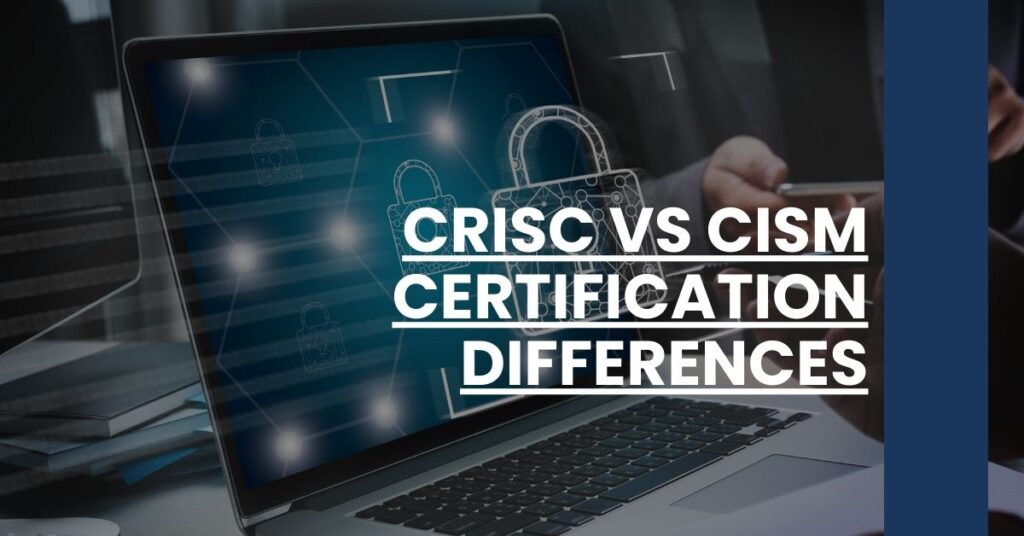Are you navigating the crossroads of risk management and information security careers? Understanding the difference between CRISC vs CISM certifications is pivotal.
This article slices through the complexity, offering a clear comparison of these two distinguished credentials. It arms IT professionals with the knowledge to select the certification that aligns seamlessly with their career trajectory.
- 1. Defining CISM and CRISC Certifications
- 2. The Focus Areas and Domains Covered
- 3. Eligibility and Requirements
- 4. Exam Content and Structure
- 5. Career Path and Job Roles
- 6. Continuing Education and Maintenance
- 7. Return on Investment: Costs vs. Benefits
- Related Topic: Broader IT Security Certification Landscape
- Conclusion: Making the Right Choice for Your Career
1. Defining CISM and CRISC Certifications
In the realm of information technology, certifications are the cornerstone of credibility, specialization, and expertise—and when it comes to enhancing your professional journey in IT security and risk management, two coveted credentials stand out: CISM (Certified Information Security Manager) and CRISC (Certified in Risk and Information Systems Control). These certifications are your golden tickets to advancing your career trajectory, and choosing the right one could solidify your position as an industry vanguard.
- CISM Certification: Designed by ISACA, a global association devoted to IT professionals, the CISM certification is your passport to the upper echelons of information security management. If you’re passionate about devising robust security programs, managing an organization’s security posture, and aligning security strategies with broader business goals, CISM is your stepping stone to achieving that reality. This credential encapsulates the essence of governance, risk management, program development, and incident response with a managerial lense.
- CRISC Certification: Also flowing from the fountain of ISACA’s globally recognized standards, CRISC centers squarely on the nexus of risk management and information systems control. It’s a specialization with precision, intended for IT professionals who yearn to identify, evaluate, and navigate potential tech risks that can tilt the scales against an organization’s operational stability. CRISC arms you with the acumen to assess, manage, and mitigate IT risks and serves as a testament to your expertise in risk identification, assessment, response, and monitoring.
Understanding the inherent focuses of CISM and CRISC is the first step in determining which certification journey aligns with your career objectives. Whether you aim to become an information security maestro (CISM) or a risk management savant (CRISC), remember that you’re not just earning a certificate — you’re sculpting a niche of proficiency that can set you apart in a crowded field.
2. The Focus Areas and Domains Covered
Delineating the knowledge areas addressed by CRISC vs CISM certifications gives you a clear map of the terrain each encompasses and its pertinence to certain roles within the industry. Let’s unpack the territory these certifications cover:
CISM envelops a broad spectrum, designed to fortify your capacity in strategic security management:
- Information Security Governance: Instilling best practices for maintaining and governing an organization’s information security posture.
- Risk Management: Methods to identify and manage information security risks effectively.
- Information Security Program Development and Management: Crafting and administering information security programs that shield against potential infractions.
- Information Security Incident Management: Preparing for, responding to, and recovering from security incidents.
Meanwhile, CRISC zeroes in on the facets of IT risk management:
- Risk Identification: Spotting potential threats that could jeopardize IT systems.
- IT Risk Assessment: Weighing the potential fallout from identified risks.
- Risk Response and Mitigation: Developing and implementing strategies to dampen the impacts of risks.
- Risk and Control Monitoring and Reporting: Keeping tabs on risk scenarios and reporting the effectiveness of control measures.
As an aspiring professional, analyzing the focal areas of the CRISC vs CISM debate will reveal which certification resonates with your career vision. Are you gravitating towards shaping the overarching security strategies (CISM) or are you more inclined to dive into the intricate web of IT risk (CRISC)?
3. Eligibility and Requirements
The path to either the CISM or CRISC certification begins with meeting their respective prerequisites. While both certifications are grounded in real-world experience, they have different yardsticks for eligibility:
- CISM Requirements: ISACA requires that you demonstrate a solid five-year background in information security management. Three of those years must be in three of the CISM content domains, with waivers available in specific scenarios for up to two years based on education, other credentials, or information security management experience.
- CRISC Requirements: A minimum of three years of cumulative work experience in IT risk management and controls is mandatory before you can brandish the CRISC title. The experience must be within the last ten years or five years post-exam, across at least two CRISC domains, including one between Risk Identification and Risk Assessment.
Before setting your sights on either the CISM or CRISC certification, ensure you meet or are on track to meeting these fundamental requirements. These are not merely bureaucratic checkboxes but are critical in ensuring you have the foundation necessary to reap the full value from the sophisticated material covered in these certifications.
4. Exam Content and Structure
Preparing for the CISM or CRISC exam? Brace yourself for a rigorous but rewarding challenge. Both exams are grueling mental marathons, but understanding their structures can help demystify the journey:
CISM Exam Format:
- Four hours to test your mettle across 150 multiple-choice questions.
- A deep dive into information security management through real-world scenario-based questions.
- Expect questions that challenge your understanding of CISM’s domains—questions that require you to apply knowledge, not just recall facts.
CRISC Exam Blueprint:
- Similarly, 150 multiple-choice questions to be conquered within a four-hour window.
- The questions revolve around IT risk management, focusing on applying concepts and problem-solving within CRISC’s domains.
- Teasers here are practical and geared towards evaluating your proficiency in identifying and managing IT risks.
Preparing for either exam calls for a well-orchestrated study plan, coupled with hands-on experience that aligns with the content of the CISM exam content outline or CRISC’s equivalent. If effective risk management or security governance tickles your professional fancy, conquering these exams is a critical stepping stone.
5. Career Path and Job Roles
When exploring the terrains of information system certifications, understanding the career avenues that branch out from CRISC vs CISM certifications can ground your decisions in reality and pragmatism. These are not just accolades to grace your LinkedIn profile; they are catalysts that can boost your career to new heights.
- CISM Certified Professionals: You are looking at prestigious positions within information security management. These roles are tailored for strategists and decision-makers, individuals who define the security direction of an enterprise. Here are some of the doors that CISM can unlock for you:
- CRISC Certified Professionals: Your certified expertise can spiral you into the core of risk management. The roles that beckon respond to a growing need for IT risk expertise in a world of digital perils:
Whichever path sings to your professional aspirations, whether it’s setting the course of an entire organization’s information security policies or spearheading the battle against IT risks, CRISC vs CISM certifications are your tickets to securing a venerated position in the IT security domain.
6. Continuing Education and Maintenance
The march towards excellence doesn’t cease once you’ve conquered the CISM or CRISC exams; maintaining your certification is a commitment to continual improvement and learning. To ensure your knowledge never stagnates, both certifications have continuing education requirements—your assurance that you are perpetually atop your field.
Both CISM and CRISC certification holders must adhere to the following:
- CPE Credits: Garner a minimum of 20 hours of relevant Continuing Professional Education (CPE) credits annually, with a collective total of at least 120 CPEs every three years.
- Annual Maintenance Fee: Stay in good standing with ISACA by paying an annual maintenance fee, a small monetary testament to the lasting value of your certified status.
- Professional Conduct: Uphold the ISACA Code of Professional Ethics and standards, ensuring your actions reflect the integrity of your certification.
These requirements are not mere formalities; they are an investment in your ongoing expertise, ensuring you stay erudite, relevant, and ahead of the curve in your field. Embracing these obligations translates to harnessing the full potential of your CRISC vs CISM certifications, ensuring they remain robust in the dynamic IT landscape.
7. Return on Investment: Costs vs. Benefits
In the world of professional certifications, weighing the return on investment (ROI) is crucial—and the CRISC vs CISM debate is no exception. Understanding what these certifications entail in terms of costs and expected benefits can help you justify your investment and anticipate the valuable ROI.
Let’s break down what you can expect:
- Examination and Preparation Costs: Factor in the registration fees for the CISM or CRISC exams, plus any preparatory course or study material expenses.
- Maintenance Fees and Continuing Education: The annual maintenance fees and costs associated with accumulating CPE credits can add up but consider them as part of your investment in professional development.
- Potential Salary Uplift: Both certifications can potentially pave the way for a raise or promotion, reflective of the added value you bring to your role.
Benefits that are harder to quantify but equally significant include:
- Credibility and Recognition: Holding a CISM or CRISC certification marks you as an authority in your domain.
- Networking Opportunities: You’ll gain access to a global network of like-minded professionals.
- Enhanced Job Security: These certifications signal to employers your commitment to staying abreast of industry standards and developments.
While CISM equips you with the gravitas of security management, CRISC positions you as a guardian against IT risks—the proprietary choice depends on which domain resonates with your passion and career objectives. The potential for higher earnings and job satisfaction serves as a testament to the value both CISM and CRISC bring to professionals’ career arsenals.
Related Topic: Broader IT Security Certification Landscape
To fully appreciate the significance of CRISC vs CISM, it’s enlightening to understand their place within the larger IT security certification ecosystem. With multiple pathways available, let’s outline how these two certifications fit alongside their cousins:
- CISSP (Certified Information Systems Security Professional): An umbrella certification reflecting holistic knowledge in information security. A great pairing with either CISM or CRISC for a well-rounded expertise.
- CISA (Certified Information Systems Auditor): This leans more towards the auditing, control, and assurance of information systems, complementing the governance focus of CISM and the risk management lens of CRISC.
- CompTIA Security+: A foundational certificate that lays the groundwork for a career in IT security, beneficial before tackling the more advanced content of CISM and CRISC.
These certificates, each with unique flavours and foci, weave together to form the rich fabric of the IT security profession. Knowledge of the broad spectrum of certifications available can guide you to tailor a professional path brimming with specialized skills—a mosaic of credentials that embellish your career to your aspirations.
Conclusion: Making the Right Choice for Your Career
Distinguishing between CRISC vs CISM certifications boils down to a clear-eyed assessment of where you envision your role in the panoramic landscape of IT security and risk management.
For those charged with an enterprising spirit aiming to architect far-reaching information security strategies, CISM is your guiding star. On the flip side, if your genius lies in dissecting and neutralizing IT risks with surgical precision, then CRISC is your compass.
Whatever your choice may be, remember that in the pursuit of excellence and professional achievement, these certifications don’t just represent a finish line—they mark the beginnings of new, uncharted vocational adventures. Choose wisely, commit passionately and let your certification journey sculpt the career pinnacle you aspire to reach.

